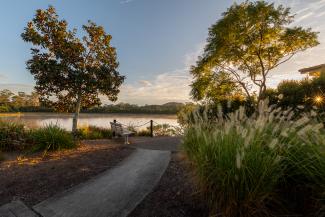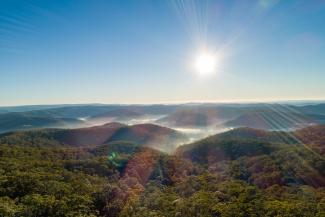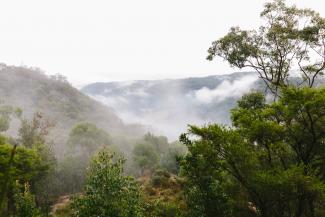Broad and diverse catchment
The Tuggerah Lakes’ catchment is as broad as it is multifaceted. The whole area stretches from the Bucketty Ridges through Somersby Plateau and Kulnura, from the fertile valleys at the foothills of the Watagan Mountains at Yarramalong, Ourimbah, Dooralong or Jilliby to the coastal and near-coastal alluvial plains at Wyong, Tuggerah, Munmorah, Bateau Bay, The Entrance and Long Jetty. We can all be proud of our biodiversity. Just as our human bodies and personalities are different, so is the environment. The lakes’ catchment has a diverse habitat that supports at least 427 native vertebrate fauna species, mammals, birds, amphibians, reptiles, fish, invertebrates, as well as hundreds of plants.
Broad and diverse catchment
Wonderful hills
Our natural world is a wondrous place. In the stretches of hills and valleys on the Central Coast, there are stands of Eucalyptus trees, including Blackbutts, Scribbly Gums, Spotted Gums and Blue Gums. Numerous bird species fly in and around the tall forest trees, roosting in the canopies, searching for food or spying on prey from above. On the ground, small marsupials such as bandicoots and antechinuses (marsupial mice) feast on the insects, earthworms and spiders hiding in the leaf litter.
Perfect streams
As water meanders along the rivers, it creates a perfect aquatic habitat for many freshwater fish, as well as other species, such as the peculiar, semi-aquatic platypus. At the same time, the plants growing on the streams’ banks, well-adapted to tolerate waterlogged soil, provide a home for frogs and insects. This lush area is called the riparian zone. It helps to absorb the energy of fast-flowing water, which, in turn, reduces erosion and creates feeding ground for the Eastern Long-necked Turtles, Eastern Water Dragons and many yabbies that come to feast on the local insects, frogs and organic matter.
The magic of wetlands
Where the water flows slowly and pools, wetlands form. The plants growing here get either seasonally soaked in water, or can stay dry for long periods. Many wading birds rely on these habitats for food and shelter, but wetlands also help to maintain water quality by filtering sediment and pollutants out before reaching the lakes.
Diverse saltmarshes
In the brackish water of the lakes where salinity and turbidity levels fluctuate, there are plenty of prawns, fish, seahorses and invertebrates living in and around the seagrass meadows. The salt-tolerant plants like to grow fringing the lakes’ edges. Here, they form saltmarsh areas that collect sediment, seagrass wrack and organic matter. These muddy foreshores are rich in microorganisms, and attract wading birds and fish looking for a meal.










